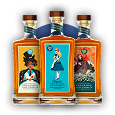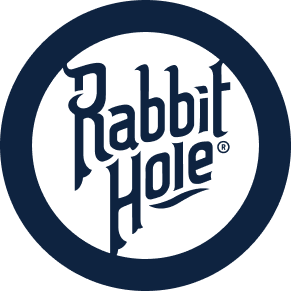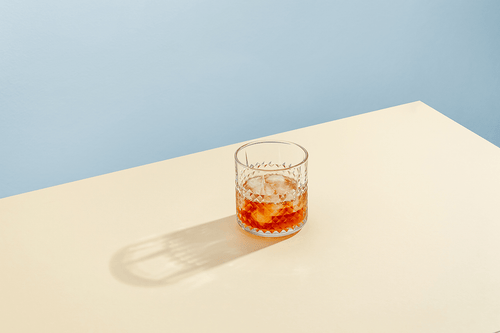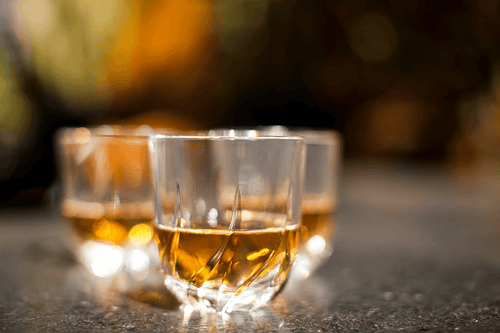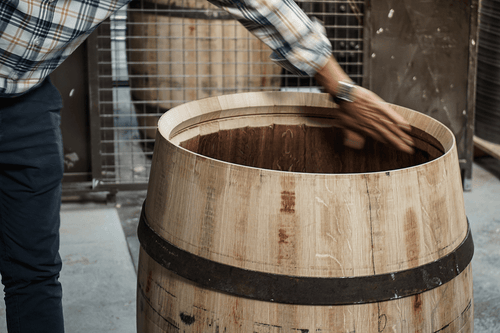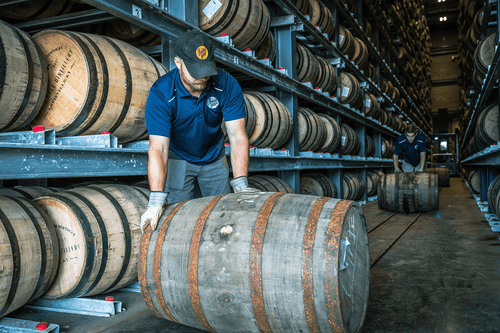Bourbon Distillation: A Complete Guide
BOURBON DISTILLATION:
A COMPLETE GUIDE
The sweet, caramel-colored spirit known as bourbon was first produced in Kentucky in the 1800s. "Bourbon" is a term that is technically reserved for corn whiskey made to exacting standards in the United States. Bourbon Distillation is a very complex and varying process by which distillers produce their craft of love and work...

Laws of Bourbon Distillation
The Federal Standards of Identity have set the following rules for bourbon distillation and production of distilled spirits. These rules are applicable predominantly for the bourbon consumed in the U.S only. Except for Canada, the bourbon exported to other countries is not expected to meet these legal requirements during production and labeling.
- The spirit should be produced in the United States only.
- The grain mash should include at least 51% of corn.
- The bourbon should be distilled to 80% ABV or 160 proof.
- The bottled spirit should be at least 40% ABV or 80 proof. New, charred oak barrels should be used for aging the bourbon.
- The bourbon must not exceed 125 proof before entering the barrels for aging.
Alcohol Content Terms
ABV is an abbreviation for "alcohol by volume." It is the standard measurement of alcohol in a given volume of an alcoholic beverage. The "proof" is twice the alcohol content by volume. The proof limits set by the Federal Law help maintain the authenticity of bourbon, its color intensity, and congener concentration. These factors are responsible for the ethereal taste of bourbon.
If bourbon distillation is performed at a higher proof, the final yield will have a higher ABV content, but it loses some of its flavor in the process. Bourbon increases in proof as it ages. Therefore, distilleries often choose to barrel it at a lower proof.
The extra water in the distilled bourbon helps regulate the over-woody flavor, astringency, dryness, and bitterness caused by the oak barrels. The wood's polyphenolic compounds, known as tannins or wood sugars, are water-soluble. Once they dissolve in the water, they oxidize, creating a smoother whiskey.
History of Bourbon
The earliest whiskey was distilled first in Bourbon County, Kentucky, long before it was even a state, hence the name.
Immigrants from Virginia, Pennsylvania, and North Carolina settled in Kentucky, producing distilled spirits domestically on small farms and plantations.
Bourbon county proved excellent for growing corn, which became the main ingredient of this whiskey. Corn and other grains like wheat, barley, and rye were combined to form a grain mash for this Kentucky-born whiskey. The local limestone springs provided the exact kind of fresh water for bourbon distillation, thus making it the birthplace of the whiskey known today as bourbon.
Grain Selection
Most distillers stick to the typical three-grain mash bill to produce their signature bourbon. Some experiment with four grains to create original and complex straight bourbon whiskeys.
Although many brands use just the three grains, each brand has a distinct texture and flavor to offer after bourbon distillation. The same holds for four-grain bourbons. There are infinite permutations and combinations of raw ingredients, process differences, aging time, and storage conditions, which can work in favor of developing new varieties of bourbon.
Barley
Converting a grain mash into alcohol is not an easy process, and since whiskey is a grain-based spirit, it's difficult to make. Grains contain complex carbohydrates that help the plants to sprout and grow. They don't have simple sugars that assist in alcohol making. That is the reason why bourbon grain mash has malted barley in it.
Malting
Barley is moistened and allowed to sprout partially. The malted barley creates enzymes that break down complex carbohydrates in grains into sugars. This process is called malting.
The necessity of malted barley to produce a fermented liquid for bourbon distillation made the flavor of malted barley synonymous with the overall taste profile of bourbon. It became the fixed component in the grain mash besides corn.
When yeast is introduced into the grain mash, it eats the sugars produced in the malting phase, thus catalyzing the fermentation process.
Malting the grains is one way to produce the enzymes necessary for fermentation. These days, distillers use lab-created enzymes, reducing the the need to depend on malted barley. In such cases, malted barley can be skipped as an ingredient. It can now be a variable component in the grain mash, just as other flavoring grains.
Types of Bourbon
Wheated Bourbon
Wheated bourbon is relatively uncommon, yet a broad class of enthusiasts root for this variety of bourbon. As per the standard laws of bourbon manufacture, just over half the grain mash in the bourbon constitution is corn. The rest of the ingredients in regular bourbon are a traditional mixture of barley and rye in a three-grain bourbon.
In wheated bourbon, the secondary flavoring grain is wheat, and rye is skipped entirely. Before the wheated bourbon distillation process, the 51% corn content goes up to 70%-80%, with the remainder comprising wheat and barley.
Malted barley is the third grain, which accounts for approximately 7% of the grain mash. It helps in the fermentation process.
Wheat bourbon is particularly popular among novices and whiskey enthusiasts who prefer the depth of the corn sweetness instead of the spicy notes of rye bourbon.
Flavor Profile
Wheat allows the corn's natural flavors, with some sweetness and the barrel's woody flavor, to shine through. As the secondary grain, wheat adds creaminess and gradual sweetness to the spirit. Unlike rye, which gives the bourbon a dominant spicy tone, wheat brings out the contrast and subtlety of other ingredients. Wheated bourbon provides a more rounded mouthfeel and a mellow finish.
Subtract the rye from a three- or four-grain bourbon and you will notice the peculiar cereal and fruity sweetness of wheat complementing the corn and oak flavor of bourbon.
Wheat tends to incline more toward soft cereals and fruit esters. Most people prefer this flavor, making the wheated bourbon their ultimate choice.
Depending on the quality of the wheat used, the flavor of fresh bread and toffee varies with traces of butterscotch, honey, and caramel. The best wheated bourbon has a long and gentle finish.
The complex vanilla and caramel flavor and the woodiness of oak barrels of wheated bourbon make up for an entirely new bourbon variant.
Wheat helps the whiskey age better than the traditional bourbons aged over many years.
Alcohol From Grains
Wheat is one of the oldest crops that humans have cultivated. The tightly packed proteins make it an excellent food source. The method of germination of seeds involves using sugar molecules as a fuel that leads to the sprouting of seeds from the earth. This energy is the primary source that helps the wheat seedlings conduct photosynthesis on their own. This process is replicated to make alcohol from wheat.
These proteins, however, make fermentation difficult as the starch is not readily accessible to the yeast. Producing alcohol requires short molecules of sugar.
If you malt the grains, enzymes are produced, which aid in the fermentation process. These enzymes break down long starch molecules into short sugar molecules — specifically, disaccharide and monosaccharide sugar molecules. The yeast consumes these to produce alcohol.
Some grains, like malted barley, require these enzymes to convert the starches into other ingredients in the mash. Some wheated bourbons contain no malted barley. Since many distillers in the U.S. use lab-created enzymes such as Diazyme and Amylex required for fermentation, malted barley is sometimes not used.
Rye Bourbon
Rye found its way into the corn-dominated American bourbon in 1800 when the Scots-Irish immigrants tried experimenting with the spirits. With the climate of North America being unfavorable for growing barley, rye found its way into the grain mash.
Although no specific percentage of rye defines high rye bourbon, it is safe to say that after corn, the second ingredient has to be rye by a portion of the compositional hierarchy.
Generally, 70%-80% of bourbon is corn, and the remaining 20%-30% is divided among the other grains per the distiller's bourbon distillation parameters. The more traditional ones have 8%-10% rye. If the rye portion in bourbon is about 10%-15%, it is generally a low rye bourbon. The whiskey is classified as high rye bourbon when 20%-30% or more rye makes its way into the mash bill.
Considering factors like corn content as the primary grain, barley for fermentation, flavor change after the barrel aging, etc., distillers settle for rye content anywhere from 15% to 30% of the bourbon to yield a high rye bourbon. The bourbon enthusiasts who are in for a bit of pepper with sweet corn taste prefer rye bourbon without a blink.
Taste Profile
Rye is known for its spicy finish. Adding rye gives a peppery, spicy flavor, which, when paired with the sweet corn flavor of bourbon, provides a rich caramel and malty barley flavor.
Rye bourbons bridge the gap between bourbon's softer and sweeter taste profile and the greener, sharper tone of rye whiskeys. High rye bourbon doesn't have the pronounced peppery tinge that identifies with a rye whiskey, thus complementing the sweetness of corn with a nice spicy kick. It adds chili, spicy, and peppery notes to the bourbon with a few notes of herbs, grass, and licorice.
Some bourbon enthusiasts suggest that high rye bourbon is best for fall drinking. The spicy, bold tone gives a warmness to the chilly climate of autumn.
Four Grain Bourbon
Given the complex nature of the grain mash, four-grain bourbon distillation is a complicated process. Most traditional bourbons use three-grain recipes consisting of corn, rye or wheat, and malted barley. Adding one more grain to the mix changes the equation, providing depth to the bourbon.
The mash bill of a four grain bourbon constitutes approximate percentages of at least 51% corn, 22% wheat, 19% barley, and the rest 7%-8% rye. These percentages can be varied and solely depend on the distiller's unique bourbon recipe.
Choosing a Four Grain Bourbon
When trying a four-grain bourbon or a four-grain triple malt bourbon, it is essential to consider the factors beyond the mash bill. It will help you decide better if you educate yourself on the distilling caveats of the particular bourbon brand. Before purchasing, examine your four-grain bourbon against the below pointers:
- Does the four-grain bourbon differ from others? If so, in what terms?
- Does this four-grain bourbon have other attributes in terms of malting, bourbon distillation method, or barrel aging?
- What taste profile was the end goal of the four grains or three malted grains?
Unlike the traditional three-grain bourbon, a four-grain bourbon ideally exceeds expectations with its complex taste profile.
The Process of Making Bourbon
Fermentation
Fermentation is considered to be the first step in the bourbon distillation process. Yeast is a single-cell organism that initiates the fermentation of grain mash. It is introduced in this phase so that it eats the sugar in the solution. It produces alcohol, carbon dioxide, and heat as side products.
The sugars needed for fermentation are readily present if the spirit is fruit-based, like grapes. But, when making spirits from grains or potatoes, you heat the mixture in hot water to produce a grain mash. Then, you add enzymes that break down the starch and complex carbohydrates into simple, fermentable sugars.
The corn is ground and cooked to extract the natural sugar content. The yeast strains are added to the soup of sugary liquid and grain remnants, which eat up the sugars and convert them into alcohol. The liquid obtained after fermentation is called a "wash."
Yeast Creation
Distillers use wild or airborne yeast, brewer's yeast, or their own customized cultured yeast strains to create distinct flavors and aromas.
Many distillers use cultured lab-grown yeast for fermentation in the bourbon distillation process. The main reason for using these artificially created yeast strains is that they can be designed to impart specific flavor profiles to the alcohol produced. It also ensures that the flavors are consistent from one distillation run to the next.
Craft whiskeys use wild yeasts to create a unique taste profile for their spirit.
Fruits are the primary source for obtaining natural yeast. A sample solution is put on the carriers and bred in ovens at 95-104 degrees Fahrenheit (35-40 degrees Celsius). Distilleries store their yeast strains in cool rooms. For the perfect production of yeast, the pH of the solution should range from 5.4-5.8.
The grain bill, the yeast, and the decision to use or discard the backset together form the unique recipe of the best bourbon.
Backset
Yeast is not the only organism that eats sugars in the grain mash. Bacteria also attack the sugars causing unwanted flavors or reducing the amount of alcohol content extracted from the mix.
To avoid this, distillers add about 30% of the leftover remnants from the previous round of distillation. This leftover is called the "backset." It inhibits bacteria breeding when added to the newly created mash, followed by the yeast. Yeast can survive this acidic environment and initiate the fermentation process.
A malt extract in a glass container is added with a small amount of yeast. The mixture is then transferred to the container where the fermentation will occur.
Distillers carry on the fermentation process in large, heated tanks. If using a mash, they strain the liquid into the tanks. Some use starter tanks where the initial fermentation process begins before the mixture moves into a larger fermentation tank.
Fermentation tanks have a valve allowing carbon dioxide to escape, leaving the tanks with alcohol. When the yeast eats all the sugar, the fermentation process is over.
The mash is cooled down completely (77-86 degrees Fahrenheit). It is then transferred into a fermenter with the yeast. The mixture has a 9% alcohol content and is fermented here.
The fermentation process runs for three days. The alcohol content of the mixture increases in this process from 8% to 9.5%. Fermentation lasts anywhere from a few days up to a few weeks. Once complete, the fermented wash or the distilled beer is obtained. It is chunky and not suitable to taste at this stage.
Distillation
The bourbon distillation process involves distilling the wash in the columns or pot stills. The fermented wash is heated, and the alcohol vapor is condensed and collected as a liquid. Most distilleries distill the bourbon mix at least twice, but in most cases, three times.
In some scenarios, the more the spirit is distilled, the lighter and purer the final blend is. However, barrel aging can impart a slight heaviness to the liquid.
Type of Water
There's a reason why distilleries are usually located near active springs. Fresh water is required for bourbon distillation to cook the grains to extract the sugars when making bourbon. Most Kentucky distillers utilize a natural resource - Limestone Water. Many swear that it isn't "bourbon" unless limestone water was used.
Bourbon Distillation Using Copper Pots
If bourbon distillation is done in pot stills, it is generally triple distilled. The shape, size, and material of pot stills influence the flavor post the bourbon distillation process.
Copper is used in making pot stills. Copper interacts with the fermented liquid's molecules to enhance the distillate profile. Copper helps retain more raw ingredients' original flavors than column stills.
The pots have to be filled, emptied, and cleaned between batches. Most distillers use steam jackets or internal coils to heat the wash instead of using an open flame to heat pot stills.
The first distillation separates alcohol and other elements with lower boiling points in the mash. The distillate that collects at the bottom of the fermented liquid is called a wash still.
Since the boiling point of the various elements in the mash is different, distillers can play around with the temperature and the number of distillations. For instance, the size of the pot is undoubtedly a deciding factor when compared to the same mash in a column still to know which aromatic molecules will make it to the vaporized alcohol.
Another element that distillers are cautious about is collecting the most desirable flavorful liquid. The other parts of the distillate, particularly the first and last portions of the distillate that comes off the still, are either re-distilled or discarded. They contain some molecular compounds that may negatively impact the bourbon's taste. It is entirely in the distiller's interest to mark these points as per their choice and bourbon flavor.
With a pot still, executing these cuts is possible since you can remove the heads and tails from the run. The distiller boils the mixture in between these cuts to extract excellent alcohol. In column stills, this doesn't work. Everything that is distilled either comes out as vapor or accumulates at the bottom of the still.
Bourbon Distillation Using Columns
The end goal of column stills is the same as pot stills: to yield the alcohol and other flavor vapors that have different boiling points out of the wash.
The pillar-shaped column is filled with beer in the middle position and is heated from below. The liquid beer runs through the tubes, whereas the alcohol vapors flow upward to the holes. The process continues as long as liquid beer is still entering the column.
The contents froth and bubble, extracting the molecules and vapors out of the liquid. While the alcohol vapor moves upward, the liquid remnants accumulate at the bottom. This product is called "stillage" and is used as animal feed or sour mash.
Alcohol is vaporized at 173 degrees Fahrenheit, so the liquid collected is higher in alcoholic strength.
The distillate obtained is called low wine. It is re-distilled to increase the alcoholic strength.
Copper Floors
Perforated plates are used as floors along the entire length of the columns. These plates capture husks, seeds, and other grain remnants. The starchy liquid falls to the bottom. The hot steam at the bottom becomes cooler as it rises, vaporizing alcohols and flavors as it meets the falling wash. Since alcohol has a lower boiling point, the cooler temperatures at the top are where the alcohol and the aromatic spirit condenses. The wash falls with its alcohol content removed to the bottom of the still.
The Second Round of Distillation
The extracted alcohol is led to the doubler copper port, which improves the bourbon's flavor. The vapor is again sent to the condenser to liquefy. The liquid extracted at this point is called the "white dog."
Bourbon distillation cannot be done at higher than 160 proof. In a column, it is possible to get the highest amount of alcohol vapor. It becomes cost-efficient for distillers since a more purified steam equals higher profits. But, when the alcohol content is too high, there's no room for other flavor elements. Thus, the blend loses its character. All it becomes is a neutral grain spirit with a less delicious experience. This is why a legal distillation limit is set to 160 proof.
Continuous Still
In a traditional pot still, there's no way to achieve continuous bourbon distillation. You can only distill what's already in the pot. It isn't a very efficient method of distillation. However, it increases the alcohol content at the end of the first run. That is why you need multiple runs in the pot stills to get the right quality and quantity of bourbon.
This issue does not occur when a column still is used. The copper plate floors are stacked throughout the column. Each plate acts as a pot, where some liquid is condensed and some is re-vaporized when steam heat is added at the bottom. It continues to move up the column with higher alcohol content, and the undesirable portion of the wash moves to the bottom of the column.
The number of plates in your still limits the alcohol content of your spirit. The more plates, the more you can distill a higher proof spirit.
A column is called a continuous still because it runs as long as the inputs and outputs remain constant. If the same values of parameters like flow rate, consistency, and temperature are maintained, it is possible to yield a consistent quality and quantity of alcohol content in the liquid.
This process of bourbon distillation can continue indefinitely as long the new beer and steam are added to the still. Hence, it's called a continuous still.
Barrel Aging
The law states that after the bourbon distillation process, it must be aged in charred new oak barrels. The barrels have to be watertight, but being airtight is not necessary. The insides of the barrel must be charred with fire.
There is no size and shape restriction on the charred barrels. However, many distillers have found that smaller barrels provide more surface area per drop of bourbon to interact with the barrel. It can seep deeper into the charred barrels, thus adding more character and wood flavor to the bourbon in less time. The temperature and climate of the storage place of barrels in the warehouse also play a vital role in the final taste of the bourbon.
The barrels are crafted by steaming seasoned oak staves. In some cases, the barrels are then toasted to make the wood sugar caramelize. In other cases, the barrel will go straight to the charring phase, which uses a more substantial fire for anywhere from a few seconds to a few minutes to create a charcoal layer on inside of the barrel. The barrels are then ready to be transported and filled with bourbon for aging.
Large barrels provide less character to bourbon but make the distillation process more cost-efficient for the distiller.
The amount of time for barrel aging is entirely dependent on the distiller. The law sets no specific duration, so if bourbon is aged just for a day or four years, it could still be called bourbon. However, the aging duration has given rise to the following bourbon classifications:
- Standard Bourbon: The spirit is bottled at 40% ABV. The bourbon is aged for a minimum of two years in charred oak barrels. It can range up to four years if not mentioned on the label. External additions of water and caramel coloring are permitted.
- Straight Bourbon: The bourbon is aged in a charred new oak barrel for two years at least. It is bottled at 80 proof, and caramel coloring is forbidden.
- Bottled-in-Bond: Bottled in bond mean all the bourbon came from a single distilling season and has been aged for a minimum of four years. It is bottled at 100 proof (50% ABV).
The higher the alcohol content of the drink after bourbon distillation, the less flavor and character the spirit will have in the end. The bourbon must be barreled at no more than 125 proof. Some distillers barrel the bourbon at lower than 125. Still, capping the alcohol content at 125 means whiskey enthusiasts will get an excellent, flavorful experience in their bottle.
Storage
Once the bourbon distillation process is over, barreled bourbon is left to mature (age) in warehouses for as long as the distiller chooses. The distiller takes the first sips of the spirit and decides if the bourbon is ready to hit the shelves.
The barrels of bourbon are stored in warehouses with different floors or levels, creating different heights for the bourbon to age. The blend from different levels, and even from one barrel to the next, may taste slightly different within the same batch of bourbon. The barrel's temperature, climate, and position affect the aging process.
Even if it is a small batch, bourbon from different barrels can taste different. That is why producers blend the bourbon to create a more consistent and delicious flavor profile.
Filtration
If you ask, "What's the difference between chill filtered and non-chill-filtered bourbon?" your bartender may demonstrate the distinction by adding some chilled water to the under-spirited, non-chill-filtered bourbon. They will show you the haze in the blend and lumps at the bottom of your glass. That haziness is due to the extra elements in the bourbon.
Before bottling, distillers may chill-filter the bourbon to remove any long-chain protein molecules and impurities that may cause the spirit to become hazy or cloudy when stored at low temperatures. To ensure the proper alcohol content, distillers test and dilute their product with filtered water before or after aging.
Some water is added to the bourbon to reduce the strength of the spirit. Not only does this make a batch of whiskey go further, but it can also improve the whiskey's flavor profile and make it much more enjoyable.
The Need for Filtration
The process of producing whiskey goes through fermentation of the grain mash of the core ingredients, bourbon distillation, and barrel aging before bottling. As a result of these processes, acetone, esters, fatty lipids, tannins, and other byproducts are produced. These extra sediments are called congeners. They have a significant contribution to the texture and flavor of the bourbon.
During transportation, the aged non-chill filtered bourbon can get subjected to cold temperatures. The non-chill filtered bourbon can become hazy and have deposits settling at the bottom. It can also happen at room temperature when water is added to the non-chill-filtered bourbon. These extra sediments called congeners can alter the texture of bourbon and its flavor.
The extra elements in the alcohol left after bourbon distillation are responsible for the haziness in the alcohol. The haze in the drink may appear as lumps at the bottom of the drink.
Bourbon distillers care about their product's shelf appeal, so they may chill-filter their bourbon to prevent any inconsistent formations that can happen due to extreme temperatures.
The Chill Filtration Process
As the name suggests, bourbon is cooled to lower temperatures — around 32 degrees Fahrenheit — during the chill filtration process. At these low temperatures, the sediments and residue in the unfiltered bourbon clump together.
The congeners left behind after bourbon distillation bind together during transport when they are naturally subjected to low temperatures. This process is called "flocculation," and the large clumps of extra elements in the bourbon are called "floc."
The floc is then filtered off to obtain a clearer liquid. The filtered alcohol then makes its way into the bottles.
As per many distillers, chill filtration provides better shelf stability, visual appeal, and consistency to the bourbon. However, many bourbon enthusiasts insist that the chill-filtration process negatively affects the overall experience of drinking bourbon. It subdues the mouthfeel and natural flavor notes that would otherwise give the bourbon complexity and differentiation.
Non-Chill Filtered Bourbon
When bourbon is not chill filtered, it is labeled so on the bottle. It implies that the bourbon has not gone through the flocculation process and is not chill filtered. It means that the extra sediments are present in the bourbon. They are the reason for the rich, creamy texture and the earthy flavor of the drink. The natural congeners are not sieved away from the drink, thus keeping the authentic characteristics of the bourbon intact.
Passionate bourbon enthusiasts prefer their bourbon to be non-chill filtered. They don't care about the hazy texture as long as the bourbon has a unique taste and aroma. Some distillers prefer not to chill filter their product, as they may lose their signature element in the bourbon that makes their brand stand out in the market.
When Is Bourbon Chill Filtered?
Distillers don't usually prefer to chill filter their product after the bourbon distillation process because there is a better way to avoid flocculation at low temperatures. Whiskey makers say that haziness occurs only when the bourbon is below 92 proof, or 46% ABV. If the bourbon is bottled at 107 proof or higher, it won't cloud even in sub-zero temperatures.
Most non-chill filtered bourbons have a higher proof that is above 92 proof. When the spirit is over-proofed and bottled above floc point, it does not need to be chill-filtered.
Market Survey
The consumer demand of the market suggests that the texture of the bourbon matters as much as its flavor. Some consumer countries have a strict requirement of a clear blend of bourbon, while some have their focus on the uniqueness of bourbon's flavor profile only.
A select few distillers have found ways to achieve both. Distillers choose between ensuring a clear blend of bourbon and retaining maximum taste to meet demand.
Bourbon enthusiasts root for the authentic taste of spirits. Bourbon with a thin, watery taste and no singular flavor profile is considered an average or low-quality bourbon. Many products bottled at 40% ABV belong to this category. Some bourbon drinkers don't mind the sediments at the bottom of their drink since these sediments are responsible for the distinct flavors of the drink. Chill filtration is often seen as a cosmetic metric for novices and others unaware of bourbon's flavor depth. This class of consumers does not prefer chill-filtration. Instead, they would like their bourbon to retain its taste profile rather than to look presentable.
Chill Filtered or Non-Chill Filtered?
Top brands take into account the temperature at which filtration will occur and the materials used to make the filters. They go through the entire process of understanding the chemistry of their new expressions to finally crack into its best texture without stripping the bourbon of its authenticity. Such editions of bourbon give the consumers the pleasure of drinking whiskey straight out of the barrel, even though it has undergone chill filtration. These brands are so meticulous with their filtration processes that even educated whiskey drinkers find it difficult to tell the difference.
Whiskey statistics prove that tasters could correctly identify only 50% of samples as chill-filtered or non-chill-filtered bourbon. This percentage could equate to mere guesswork, thus concluding that the filtration process is not easily identifiable by consumers.
It would therefore be wrong to conclude that only non-chill-filtered bourbon is high-quality whiskey. Chill filtration may or may not be necessary at all times, but it needn't be ruled out entirely as different consumer markets respond to different choices for their bourbon.
Bottling
The last step before the bourbon is offered for consumption is bottling. The bourbon is transferred from the barrels into bottles for selling and distribution.
There exist many factors that influence the taste profile of bourbons like grain mash, water, yeast, bourbon distillation style, and distillation proof. However, the final taste of bottled bourbon is bound to vary also due to the barrel's char level as well as overall aging conditions like warehouse location, maturation time, and bottle proof.
The bourbon distillation process is a complicated one consisting of many processes that finally lead to the end product, which is bottled bourbon ready for sale on the shelves. Knowing the various methods and intricacies of the bourbon distillation process allows us to choose the best bourbon that will provide complete satisfaction.














